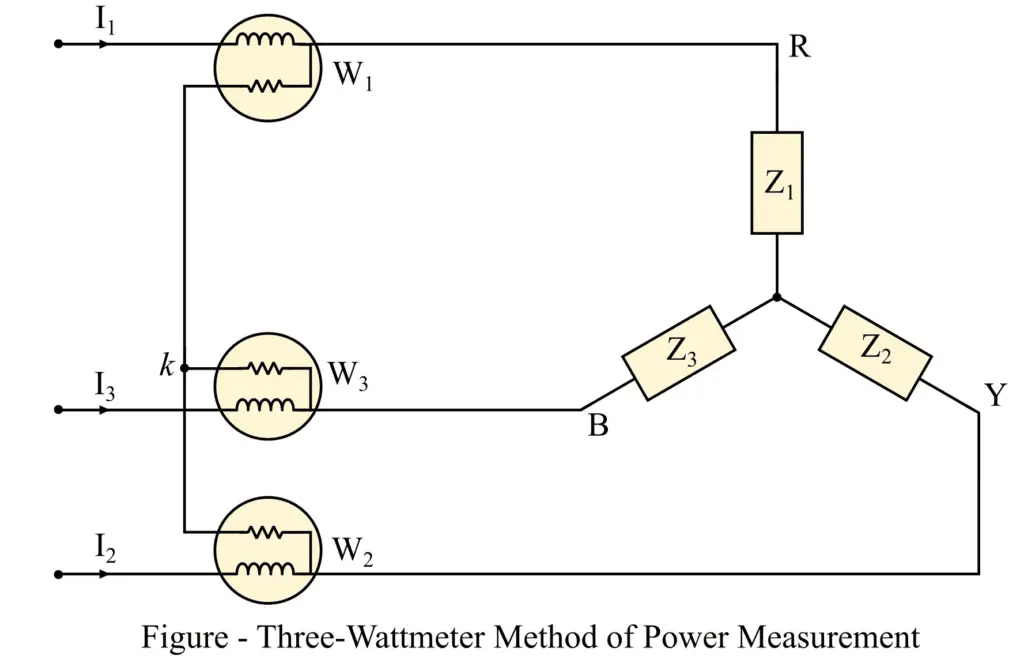In this article, we will discuss the measurement of three-phase power by a three-wattmeter method. In alternating current (AC) electric circuits, the electric power is measured with the help of a measuring instrument named a wattmeter.
A wattmeter is an electrical measuring instrument consisting of two coils namely a current coil and a pressure (potential) coil. The current coil of the wattmeter has low resistance so that it can carry the full load current, while the pressure or potential coil has high resistance and it carries a current proportional to the voltage across the load.
In three-phase ac circuits, the measurement of power seems to be very simple at first glance, but it is a slightly complicated practice. It is because we have to connect only one wattmeter in each of the three phases and then add the readings of these three wattmeters algebraically to obtain the total electrical power consumed in the circuit. This procedure of three-phase power measurement is certainly impracticable and also uneconomic.
Technically, in many situations, the neutral wire of the star-connected system is not accessible. In the case of delta connected system, the phases are not available for the insertion of wattmeters in each phase. Thus, in most practices, there are only three line conductors available in a three-phase system.
Numbers of wattmeter
The number of wattmeters needed for power measurement in a polyphase system is determined by Blondel’s Theorem.
According to Blondel’s theorem – Suppose N wires supply power in an AC system, then the number of wattmeters required to measure power is one less than the number of wires i.e. (N-I), notwithstanding the load is balanced or unbalanced.
Thus, three-wattmeters are required to measure power in a 3-phase 4-wire system, and 2-wattmeters are needed to measure power in a 3-phase 3-wire system.
Numbers of wattmeter
Three-Wattmeter Method
In the three-wattmeter method of three-phase power measurement, three separate wattmeters are inserted in the three-phase system. These three-wattmeters are connected in such a way that each wattmeter has its current coil connected in a series of the line wire, and its potential coil connected between that line wire and some common point (say k).
The circuit diagram of the three-wattmeter method of power measurement is shown in the following figure.

Therefore, we have used three separate wattmeters namely W1, W2, and W3. The one end of the three wattmeters’ potential coils is connected to the common point k. If a neutral point is available in the three-phase system, then the common point k should be connected to that neutral point.
The total power in the three-wattmeter method of three-phase power measurement is obtained by the algebraic sum of readings of the three wattmeters, i.e.

Where, the powers W1, W2 and W3 are given by,
Electric power consumed in phase 1:

Electric power consumed in phase 2:

Electric power consumed in phase 3:

Thus, the power measured by an individual wattmeter is the product of the phase current and the line voltage.
Advantages of Three-Wattmeter Method
The following are the significant advantages of the three-wattmeter method of three-phase power measurement-
- Three wattmeter method measures the power consumed in each phase of the three-phase system. Hence, it is possible to get power readings of the individual phases.
- In a three-wattmeter method, the algebraic sum of three-wattmeter readings simply gives the total electric power consumed in the circuit, whether it is balanced or not.
- If the neutral wire is not available in the system, then a duplicate neutral can be created.
Disadvantages of Three-Wattmeter Method
The following are the most significant disadvantages of the three-wattmeter method-
- It is a relatively expensive method of power measurement because it needs three wattmeters each for one phase.
- Three wattmeter method is susceptible in case of heavy loads.
Applications of Three-Wattmeter Method
The following are the applications of the three-wattmeter method of power measurement-
- Three wattmeter method is mainly used where it is required to measure the power consumed in each phase of a three-phase system.
- A three-wattmeter method is used in electric power systems to monitor power consumption.
- Three-wattmeter is also used in industrial electric systems to measure power when the load is unbalanced, etc.
Numerical Example
Three wattmeter method is used to measure the power absorbed by a 3-phase induction motor. The readings of two wattmeters are 12.5 kW and 5.8 kW. If the total power consumed by the motor is 21.5 kW, then determine the reading of the third wattmeter.
Solution – Given data,

Thus, according to the theory of the three-wattmeter method, the total power consumed is given by,

Thus, the third wattmeter will show 3.2 kW of power consumed.